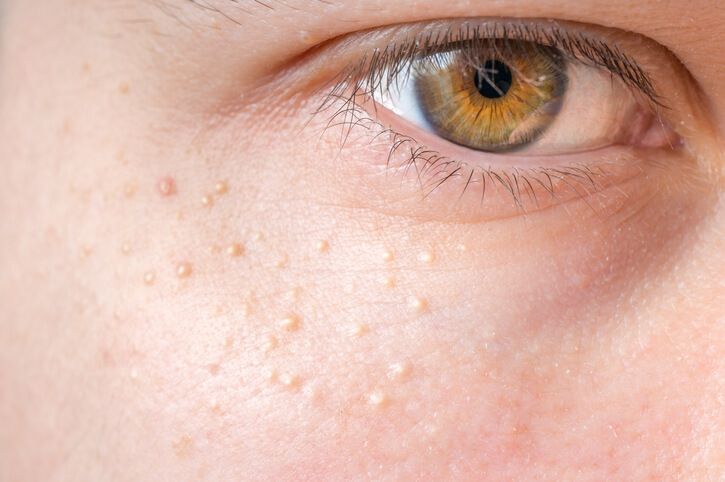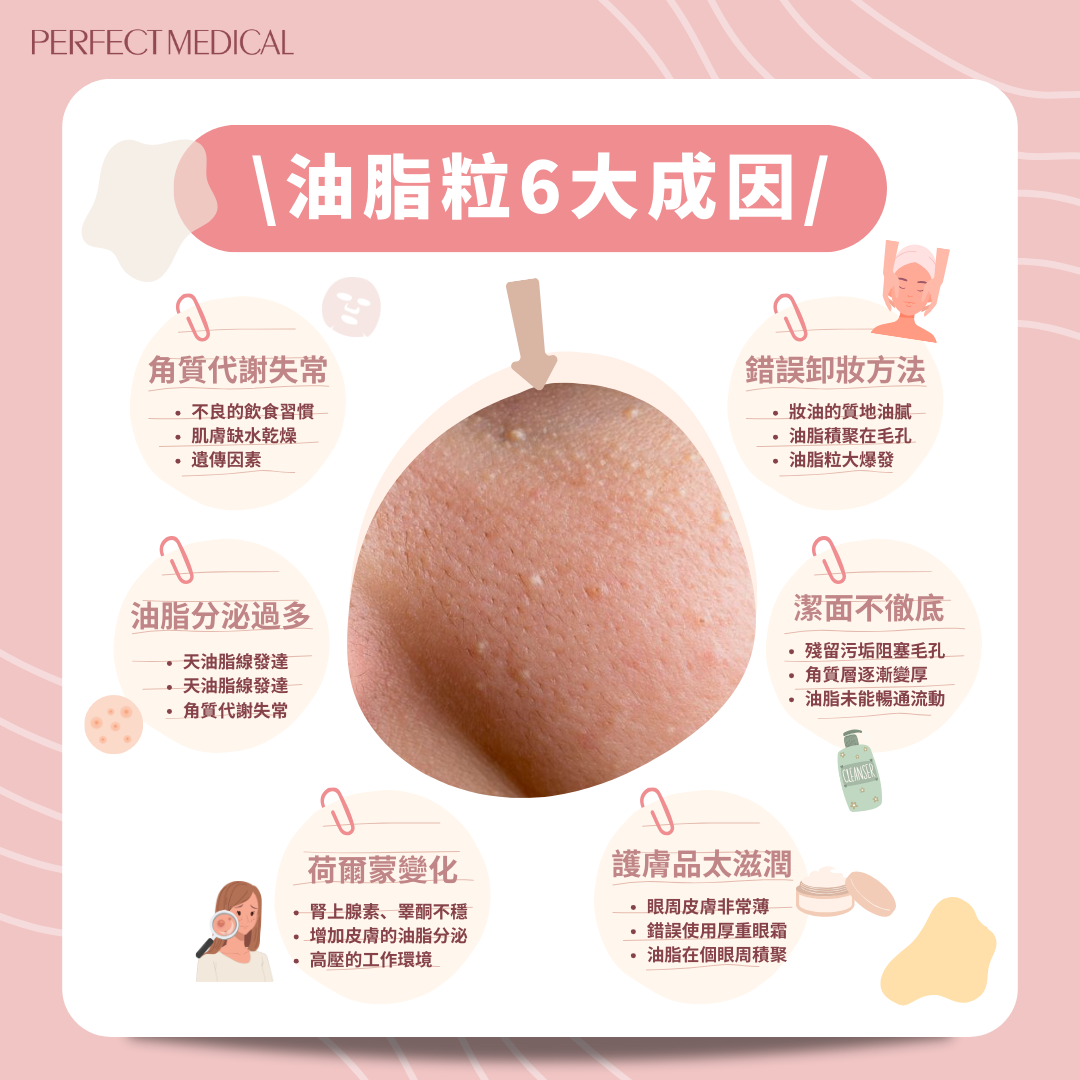- Home
- Trend
- Weight Loss Strategies
- Acne Tips
- Hair Health Information
- Blemish Removal Tips
- Acne Scar Removal Tips
- Muscle Building Techniques
- Intimate Care Tips
- Postpartum Intimate Care
- Eye Bags Wiki
- Tips for Face Slimming
- Secret of Permanent Hair Removal
- Breast Enlargement Tips
- Cure to Snoring
- Marionette Lines
- Skin-Tightening Secrets
Milia can be even more stubborn than acne! While acne is undeniably annoying, it can typically heal completely in a matter of weeks with proper care and leave no trace. Milia, on the other hand, are far more persistent. These small, raised bumps—often likened to white sesame seeds—lack the pus-filled heads that acne has and can linger on the skin for months without going away. In most cases, you’ll eventually need aesthetic treatments to remove them. So what can you do when milia appear? This all-in-one “Milia Guide” is just what you need—it’ll teach you the best ways to tackle milia!
What Are Milia?

Milia can appear anywhere on the face. They are small, yellowish-white, grain-like bumps caused by excess sebum clogging the sebaceous glands. They feel slightly firm to the touch but are not hard. Regardless of gender or skin type—even those with dry skin—anyone can develop milia. They most commonly appear around the delicate eye area, where they are round, clustered, and difficult to remove once they form.
What Causes Milia on the Face?

There’s a saying: “There are no ugly women, only lazy ones.” Many women are diligent about skincare, but overdoing it is actually one of the main culprits behind milia. Overly rich products can be hard for the skin to absorb, leading to blocked pores and milia. Here are other key causes:
Cause #1: Abnormal Keratinization
Poor diet, dehydrated skin, genetics, and hormonal fluctuations can all disrupt keratin metabolism. When layers of dead skin build up on the surface, sebum gets trapped underneath and forms tiny raised bumps.
Cause #2: Excess Sebum Production
People with oily skin tend to have more active sebaceous glands, making clogged pores and milia more likely—especially when thickened keratin layers are also present.
Cause #3: Incorrect Makeup Removal
Many women use cleansing oils for full-face makeup removal. However, cleansing oils aren’t suitable for everyone—especially those with oily skin—as they can easily clog pores. If not thoroughly rinsed off, oily residues can lead to a milia breakout.
Cause #4: Inadequate Cleansing
Cleansing is a crucial step in skincare. To prevent keratin buildup, thorough cleansing and regular exfoliation are essential. Residual dirt easily clogs pores and traps sebum, giving milia a chance to form.
Cause #5: Overly Rich Skincare Products
Skincare must be tailored to your skin type. Using overly thick eye creams can increase the likelihood of milia—especially since the skin around the eyes is very thin. Heavy eye creams can easily lead to oil buildup in this area, forming milia over time.
Cause #6: Hormonal Changes
Unstable levels of adrenaline and testosterone can stimulate excessive sebum production. Factors like frequent late nights or stressful work environments can disrupt hormonal balance and hinder proper skin metabolism—greatly increasing the chances of developing milia.
免費體驗
Acne Treatment
1 Minute Self-Registration
Date should not be before minimal date
Did You Know? There Are 2 Types of Milia
Milia can appear on any skin type—even dry skin—and are commonly found on the face. There are two main types:
Type #1: Syringoma
Syringoma is a benign skin tumor composed of sweat duct cells. Due to overgrowth of sweat ducts, these become more prominent and translucent in hot weather when sweat glands are overactive. They feel soft and can extend into the dermis, but are harmless to health.
Type #2: Primary Milia (Milia Seeds)
These look like tiny yellowish-white grains, often around the eyes. Caused by keratin buildup at sweat gland openings, they trap sebum beneath the skin. Frequently rubbing the eyes or using overly rich eye creams can lead to micro-injuries and accelerate their formation.
Quick Facts: Milia vs. Fat Granules vs. Comedones
Many people confuse milia with fat granules (lipomas). They look similar—small, white bumps on the skin—but milia don’t release anything when squeezed, while fat granules may eject small particles.
Comedones, often called “closed comedones,” are considered early-stage acne. They’re flesh-toned, slightly raised, and form when overactive oil glands and abnormal keratinization block the pores. Left untreated, comedones can turn into milia or even full-blown acne if bacteria and air exposure cause inflammation.
How to Improve Milia: 5 Daily Tips
Once milia form, they can stick around for months. Here’s how to deal with them:
Tip #1: Proper Makeup Removal & Cleansing
Cleanse twice a day using gentle products. Don’t over-cleanse, or your skin may become dry and produce even more oil. Always thoroughly remove makeup to prevent buildup that clogs pores. Avoid overly greasy cleansing oils, which can leave residue that causes milia.
Tip #2: Maintain Water-Oil Balance
An imbalance in moisture and oil can trigger excessive sebum production. Use hydrating serums and essences suitable for your skin type—not just toner—to ensure deep moisture absorption.
Tip #3: Regular Exfoliation
Thickened dead skin can clog pores, so exfoliate 1–2 times a week using scrubs, deep-cleansing masks, or gentle acids. Don’t overdo it, though, as excessive exfoliation can damage the skin barrier.
Tip #4: Avoid Over-Nourishing Products
Heavy products that the skin can't absorb will linger and cause problems. Choose skincare with appropriate textures, especially around the eyes. Follow instructions when using eye masks and other treatments.
Tip #5: Professional Extraction (Comedone Removal)
For faster results, consider extraction. But don’t do it yourself—improper technique or tools can cause inflammation or scarring. Leave it to trained professionals.
免費體驗
Acne Treatment
1 Minute Self-Registration
Date should not be before minimal date
3 Professional Treatments for Milia
If your face is covered with milia and it’s affecting your appearance or confidence, consider these medical aesthetic treatments:
Treatment #1: Acid-Based Products
Salicylic acid helps exfoliate dead skin and clear out sebum inside pores. Many anti-milia products contain fruit acids to gently remove buildup and restore smooth skin.
Treatment #2: Oral Isotretinoin (A Acid)
This reduces sebum production and bacteria, accelerating skin turnover. While effective for severe milia and comedones, it can cause dryness and temporary flare-ups at first.
Treatment #3: Laser Therapy
Lasers (with wavelengths of 10600–10800nm) vaporize milia on the skin surface, drying them out so they fall off naturally. This is also effective for syringoma and other benign skin issues.
Editor’s Real-Life Test: Milia Emergency Treatment – Visible Results in 1 Week!
Since milia don’t have an opening, regular skincare isn’t enough to eliminate them. Our beauty editor tried Perfect Medical’s Acne Treatment, which claims to balance oil levels and unclog pores. Here’s what happened:
The treatment uses vacuum microdermabrasion to gently remove dead skin and clear out pores—preventing future milia, blackheads, and acne.
Surprisingly, the process was painless—just a light suction sensation. There was some redness afterward, but it disappeared after a hydrating mask.
One week after the treatment, milia on the nose and chin were visibly reduced. The skin felt slightly bumpy to the touch, but no milia could be seen. Results were amazing! With weekly sessions, milia can be completely eliminated.
If you’re troubled by milia, this treatment is definitely worth trying—even sensitive skin types can benefit. Don’t miss out on Perfect Medical’s special reader offer: register online for a free trial session (limited spots)!
Free Trial: Perfect Medical Acne Treatment免費體驗
Acne Treatment
1 Minute Self-Registration
Date should not be before minimal date
FAQ

What causes milia to form?
Poor dietary habits, dehydrated or dry skin, genetic factors, and hormonal fluctuations can all disrupt the skin’s keratinization process, slowing it down. When a thick layer of dead skin builds up on the surface, sebum cannot be discharged properly, resulting in the formation of raised oil-seed-like bumps on the skin. In addition, incorrect makeup removal methods can cause oil to accumulate in the pores, triggering a milia outbreak. Insufficient cleansing can also lead to a gradual thickening of the stratum corneum. If dirt and residue are not properly removed, the pores can easily become blocked. When sebum cannot flow freely, milia will seize the opportunity to appear quietly on the face.
What types of milia are there?
Milia can be categorized into syringoma and primary milia (milia seeds). Syringoma is a benign skin tumor composed of sweat duct cells. It results from overgrowth of the sweat ducts. During hot weather, when sweat gland activity increases, these become larger and more translucent, with a soft texture. Primary milia resemble tiny yellowish-white grains and are often found around the eyes. They are formed when keratin builds up at the openings of the sweat glands, blocking the release of sebum. Frequently rubbing the eyes or applying rich eye creams can create micro-injuries on the skin, which, when combined with heavy skincare, can accelerate the development of milia.
What’s the difference between milia and comedones (clogged pores)?
Comedones, also known as closed comedones, are flesh-toned bumps that feel like raised granules under the skin. They occur when sebaceous glands secrete too much oil, and the skin's keratinization process is abnormal or sluggish. When sebum cannot be discharged properly, comedones form. If left untreated, they can gradually develop into milia. In severe cases, the oil inside the comedones may come into contact with air and bacteria, turning into inflamed acne.
Are there any recommended treatments for removing milia?
Perfect Medical’s Acne Treatment uses a unique vacuum microdermabrasion technique that gently and painlessly removes dead skin and exfoliates the stratum corneum. This unclogs pores, preventing sebum from getting trapped deep inside, and helps women prevent and reduce milia formation. The same treatment can also improve most types of acne—such as cystic acne, comedones, blackheads, nodules, and hormonal acne—truly helping to heal acne and prevent future recurrence!
Is the treatment at Perfect Medical safe?
Perfect Medical’s Acne Treatment uses two applicators. One gently and painlessly removes dead skin cells, leaving the skin smooth and refined. The other uses an infusion-based purifying formula that delivers active serums deep into the skin while balancing oil production, clearing pores, and effectively dissolving blackheads and whiteheads. This is a non-invasive acne treatment that uses breakthrough technology to infuse active ingredients into the skin without damaging its natural barrier. The procedure is safe and reliable, with no need for medication or injections. Women can return to their daily routines immediately after the treatment—it’s extremely safe!









